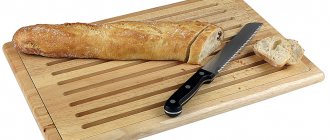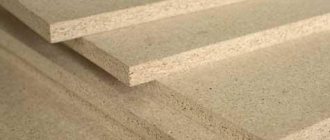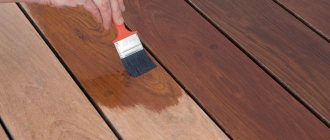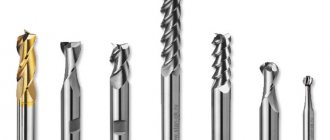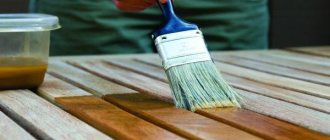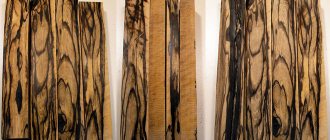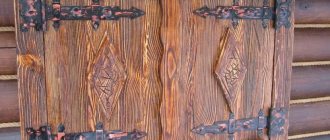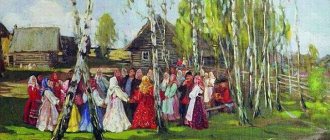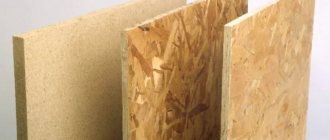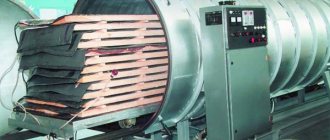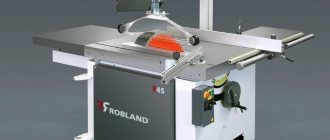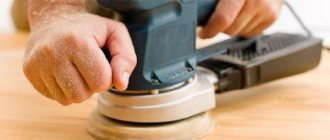For interior decoration and cladding of facades, lining is often used because of its low price and ease of installation. But the lining can be very different, differing in the type of wood and profile, size and grade; naturally, each variety is chosen for a specific task. This article is dedicated to clapboard. You will find a detailed description of the material and our range on the catalog page.
catalog
If you are thinking about which lining to choose, then you need to understand the characteristics and classification, as well as decide on the goals and objectives of the upcoming work.
No. 2. What is the difference between ordinary lining and eurolining?
On the construction market you can find both ordinary wood lining and those with the “euro” prefix. The extreme one is significantly superior to ordinary lining in a number of operational characteristics. So, the main differences are as follows:
- size.
The Russian standard lining is much thicker, and its thickness can reach up to 25 mm; the thickness of the Euro lining is 13, 16 or 19 mm. The width of eurolining is very much mm, ordinary - up to mm; - lock. The protrusion of the lock in the eurolining is about mm, which allows the elements to hold tightly, even with strong changes in temperature and humidity. In an ordinary lining, the lock is often completely tiny, so the lamellas diverge during use;
- the presence of ventilation holes on the back side of the eurolining, which prevent the formation of cracks during temperature changes.
There are no similar grooves on ordinary lining;
- humidity. The eurolining is forcibly dried to a humidity level of %, which ensures the absence of any deformations during transportation, installation and operation of the finished coating. The humidity of ordinary lining reaches %, which has a bad effect both on the process of working with it and on its behavior during operation;
- appearance.
Since eurolining is made in accordance with a serious European standard and using European equipment, its front side is always smooth. If there are knots on it, they are painstakingly processed. Manufacturers, as a rule, have several types of profiles. The lock elements fit together precisely. Ordinary lining can occasionally become frayed due to its impeccable appearance and precise execution of the locking joint; often its surface is rough and fleecy; - Eurolining is sorted into classes. Depending on the presence of defects on the wood itself and defects acquired during processing, as a rule, four classes are distinguished.
It is clear that when Euro-class lining appeared on the market, almost all builders began to use it specifically.
However, ordinary lining can also be used and is used from time to time for external cladding, and in those cases when the quality of the finished surface and its appearance is not so important, and the task of saving comes to the fore.
Choosing a lining by size
When choosing a finishing board by size, the length, width and thickness of the lining are assessed. The required length of the workpieces will be determined based on the overall dimensions of the surfaces to be finished and taking into account waste minimization. For ease of selection, this indicator varies in increments of 10 centimeters; in this case, the total length of the panel can range from 30cm to 6 meters. Also, one should not lose sight of the fact that any clapboard board needs trimming.
When purchasing material, you must consider the following:
- When using a narrow board, the coating is more reliable and stable.
- Wide lining is less resistant to impact impacts.
- To enhance the decorative effect, boards of different widths are sometimes used, laid in random order.
The length-joined lining, obtained by milling a board made up of separate sections selected according to the design, deserves special consideration. The connection of elements in a spliced product is carried out using a microspike, glued under pressure.
The advantages of spliced lining include its increased stability; Moreover, in terms of its main indicators, this product is practically no different from the “Extra” lining. Its disadvantage is the limitation on the thickness of the jointed board, which cannot be less than 0.15 meters.
How to install eurolining
The instructions for installing eurolining are no different from the instructions for installing conventional lining. The difference is only in the quality of the material itself, and due to the larger size of the grooves, eurolining is easier to install.
General requirements
Before sheathing the walls or ceiling, they must be leveled using lathing, which is mounted perpendicular to the direction of fastening the boards. This can only be avoided if the eurolining is attached to a perfectly flat wooden surface with your own hands.
The lining can be laid in any direction:
- Vertical installation visually “raises” the ceilings.
- Horizontal – increases space.
- At an angle (diagonally) – allows you to create unusual design options.
Multidirectional finishing of the loggia with clapboard
Advice. The overall impression of the finish depends not only on the correct installation, but also on the quality of the eurolining itself. If you decide to save money and purchase boards with knot holes, they must be sealed with wooden plugs.
If wooden lining is used for finishing, rather than PVC euro lining, then the work should be carried out at positive ambient temperatures and low humidity. All material must be brought into the room in advance so that the boards “get used” to its microclimate.
Methods of fastening eurolining
There are several ways to attach lining to a wall or sheathing.
- Concealed with clasps. Clamps for lining are brackets made of thin galvanized steel with mounting holes. They are used for fastening eurolining of small thickness. The clamp is attached to the board, after which it fits into a groove with the previously installed one. Then the clamp is nailed to the sheathing with nails or screwed with self-tapping screws. The next board completely hides the mount.
Fastening with clamps
The video clip clearly shows how the lining is installed using this method.
- Fastening with self-tapping screws is secret and using dowels. With a hidden fastening, the self-tapping screw is screwed directly into the tenon of the eurolining. The next board is put into a groove onto the tenon and hides the screw head. If the fastening is made into the body of the board, then the screws are recessed into it and closed with wooden dowels, which are subsequently cut flush with the surface and sanded.
Installation on self-tapping screws with hidden fastening
Fastening using dowels
- Less common is fastening the lining with staples and nails, which are driven into the tenon at an angle of 45 degrees and recessed into the wood without interfering with the installation of the next board.
Main types of modern lining
Lining has many varieties, which differ in appearance, method of fastening and purpose. Two types are in great demand: standard and softline. Their main difference from each other is the shape of the chamfer: the regular type has straight corners, while the softline has the most rounded corners.
To cover surfaces located on the street, external lining is used.
Wooden cladding in this case is carried out under the headings blockhouse and American.
The blockhouse has one oval side, which is created to imitate a rounded log. This cladding gives the house the appearance of a real log house, making it more attractive and presentable. Elements that have failed can simply be replaced without disturbing the rest of the skin.
The version called American is made in the form of a planed board. A groove is cut out from one end, and a tongue and groove is cut from the other, which help to firmly connect the boards to each other. The cut side edges help to accurately copy the wood beam, so at first glance it is difficult to realize that this is actually wood lining.
American sizes differ significantly from previous versions. The boards are the most powerful, wide and strong, therefore they are intended only for external work.
Second grade
This lining (grade 2) is characterized by the presence of visible defects. There are dents, cracks, chips. But their size does not exceed 5 cm per 1 linear meter of board. On the surface of the product there is blue (up to 10% of the volume), knots, resins, and cores. Non-grooving is allowed at the ends, which does not interfere with installation.
Knots do not exceed two centimeters in diameter, their number is up to one per linear meter of material. If the knots are black, then their diameter should not exceed 1.5 cm. Rotten and falling out knots are not allowed.
Plate cracks extending into the end are acceptable, with a length not exceeding a third of the entire length of the board. Through cracks - no more than 30 cm in length. The length of plate through cracks is no more than 15 cm with a width of up to 1 mm.
Places with blue coloring or tarring are allowed one per board if their size does not exceed 10x20 cm.
Most defects are formed during the manufacturing process. Existing cracks should not be through or extend to the end of the board. Possible rot of up to 10% and wormhole (up to 3 per linear meter). For this grade, any defects are acceptable that will not interfere with the installation of the material.
Existing imperfections are usually hidden by grouting and painting in dark colors.
This class of lining is a budget option suitable for most of the population.
Lining quantity calculator
Block house
It is believed that such panels are more often used to decorate facades. However, they are no less popular among the owners of country houses, who prefer to decorate, if not the entire house, then some of the rooms with just such lining. Its peculiarity is that the front side is convex. When several boards are attached to a supporting frame, they successfully imitate the wall of a log house. See the main dimensions of the block house here.
American
This is an imitation of another lumber - timber. It is not used so often for interior decoration, but there are fans of this type of room design.
Wood species
What is the fundamental difference between them? There are only two points that any home craftsman should know about.
We advise you to study - Economical heating system for a country house based on a solid fuel boiler, from “A” to “Z”
Coniferous wood
The second feature is the specific smell in the room, which persists for a long time after finishing work is completed. From a medical point of view, microelements released by coniferous wood have a beneficial effect on the body. But not all people tolerate it.
Deciduous species
Difficulties with impregnation of the lining. The reason is the same dense structure. Any of the drugs used in such cases will definitely not work.
For example, the width for wooden lining is set from 45 to 120, and the thickness - from 13 to 16 (mm). The length is usually 2.5 or 3 m.
You can give the following advice - before drawing up an installation diagram, planning the interior decoration of the house, you should ask what kind of lining (taking into account the profile, type of wood) is available on the local market. Exactly in size.
Other Features to Consider
Grade
Everyone strives to save money wisely when decorating their home, and this is quite normal. But when choosing cheaper types of lining, you may encounter problems that will result in additional financial losses. Not to mention the time and your own nerves. Based on this, for interior decoration it is recommended to purchase lining of the highest grades (Premium, Extra, Prima) or first grade (A).
How are they different from cheaper products? Firstly, there is no so-called “core” of the tree (pulp). Consequently, the risk of rot developing in the lining structure is significantly reduced. This means that you won’t have to regularly replace individual panels. Secondly, there are fewer defects in the form of knots and “resin pockets.” And the cracks, if any, are insignificant, and no more than 2 per linear meter. By purchasing lining grades B and C, you will be able to save some money on lumber. But then you will have to think about how you can disguise the flaws in the boards. And any composition also costs money + time to work. So it turns out that when it comes to interior finishing, the savings on the type of lining are very illusory.
Specifics of the premises
If its humidity value is higher than normal, then the interior finishing should be done with eurolining. The reason is clear - wider grooves and tenons will ensure the reliability of the cladding.
Fastening technology
Only with hardware (nails, screws, staples) or special devices (clampers). All recommendations for “fitting” lining with glue (there are some on the Internet) do not stand up to criticism. Finishing panels of this type during operation partially absorb wood, swell, and deform under the influence of temperature changes. In other words, they “play.” Rigidly fixing the lining with glue will lead to the cladding “moving”. It will begin to warp, and it will no longer be possible to do without replacing individual panels (and this is putting it mildly). Actually, the issue of unscheduled repairs will be on the agenda.
On the market you can find a number of other panels, which are called lining. Plastic has already been mentioned. But there are also samples made from MDF, for example, with appropriate coating, and metals. The choice is yours, reader. But we should not forget that the original interpretation of the term lining was a finishing board made of solid wood of the correct shape. It is this type of panels, due to the characteristics of lumber (one of which is the ability to “breathe”), that allows you to maintain an acceptable microclimate in the house without additional effort and expense.
Good luck with your choice of lining for the interior decoration of your home!
Advantages and disadvantages of eurolining
The advantages of eurolining need not be mentioned; they are expressed in one word - wood. The advantages of using just such boards are that they:
- very easy to lay independently on a flat, beautiful surface;
- They can be easily filed to fit any size or defects of the premises;
- completely eliminate the possibility of drafts;
- do not require additional polishing.
The disadvantages of the material, again, include the properties of wood:
- high probability of rotting, mold formation, exposure to insect pests;
- despite all the fireproofing treatments, wood is always wood, and it burns;
- reduction of free space, both visually and actually;
- the need for long drying and processing of saw cuts;
- high cost of eurolining .
The disadvantages of this material are completely eliminated by its 100% naturalness. Not a single, even the best, cheap and practical synthetic artificial material can ever give a room the same atmosphere as wood.
Varieties
For the production of wood planks, different tree species, types of raw materials, and forms of surface treatment are used, which determines the existence of different types of products. It is much easier to choose products if you have an idea of the specific features of the material, its technical characteristics, and expected operating conditions.
When determining the grade of products, foreign manufacturers rely on European standards, while domestic manufacturers rely on both European and their own standards, developed taking into account the requirements of GOST.
Extra
The best products are designated as extra. Old-school consumers call this category premium. The highest grade lining has practically no defects: worm or ash spots, blue stains, sprouts, areas with rot. In most cases, spliced material belongs to this category, because in solid wood, be it linden, larch or other conifers, it is extremely difficult to find a large amount of ideal raw materials.
The highest grade lamellas have an absolutely smooth surface without knots, stains, chips, or cracks; it is vacuum packed in film to avoid damage during transportation and storage
Products should be secured very carefully using special adhesives. Properly installed cladding, coated with good varnish, has an elite appearance and is a worthy decoration for expensive interiors.
A (first)
According to the long-established classification, the next group of products can be called 1st grade products. Nowadays it is usually denoted by the letter A. In a minimal amount, it can have microscopic cracks and resin inclusions that do not have a through character.
The size of the knots is regulated; the diameter cannot exceed 15 mm, and the knots must not be sprouted. The maximum permissible size of black knots is 7 mm. Products of this type are most often used for cladding residential and administrative premises; The formation of a decent appearance of a high-quality surface can be completed by treating it with wax, oil or simply varnish.
B (second)
Grade B lamellas are usually called 2nd grade lining, which informs the buyer in advance about the possible presence of small defects. In each section with a length reaching 60 cm, there may be small flaws: cracks, dents, chips, with a total area of no more than 3 cm. The size of knots and bluish spots is also limited and should not occupy more than 10% of the plank area.
It is important to know that all of the indicated defects in 2nd grade products cannot have a through form
This should be noted during inspection. Installation of such lining requires experience, because the ends may contain small areas with unplaned wood
They do not interfere with joining and do not spoil the appearance of the cladding if installed correctly. Small flaws in the front surface are masked by grouting and painting.
C (third)
Grade C planks have the most stringent quality requirements and low prices; they are mainly used for finishing technical premises. Installation of such products requires experience and great effort; Additional finishing work and painting can improve the surface to some extent.
The cladding usually has knots, cracks, chips, and roughness in quantities that are noticeable to the naked eye even with a cursory inspection. Unfortunately, some manufacturing enterprises introduce completely defective material with an unlimited number of serious defects into category C, although according to standards the total area of stains should not exceed 20%. Regulatory documents do not contain restrictions on the number and shape of knots in this type of product.
When choosing lining, the buyer should study not only the accompanying certificates, but also carefully inspect the material himself. Unfortunately, unscrupulous manufacturers and trade representatives tend to sell products that are not of the best quality at inflated prices. To make a purchase, it is advisable to contact reputable suppliers with a positive reputation. Good quality lining will make the surfaces attractive for many years.
Types of lining depending on wood species
The type of wood determines both the price and certain characteristics, for which the material is selected individually for each case.
Conifers
For exterior decoration and for walls in baths and steam rooms, coniferous species are usually used, as they contain essential oils and resin, which are a barrier to moisture and fungi.
Soft spruce wood is used for exterior and interior decoration with rounded lining shapes.
And the cheapest material is pine, but the density of the wood is low, which leads to a lot of damage and scratches. In addition, pine produces resin, which when heated can cause severe skin burns, so it is not recommended to use it in steam rooms.
Larch is of high quality and price. The wood is durable, has thermal insulation properties, and increases in size over time, which cannot be said about other conifers.
Cedar has healing properties due to its distinct scent. Wood is resistant to damage and is an excellent heat insulator.
Hardwood
If we talk about hardwoods, the best of them are linden, which is scratch-resistant; alder, which has volatile compounds that have a good effect on the human body; oak, with the best quality in all respects and criteria.
There are also linings made of mahogany, but this already refers to an exotic material and has a number of pros and cons
Which lining is better to choose for cladding a house and a bathhouse?
In order not to make a mistake with the choice of lining, you need to know what parameters you need to pay attention to. The main ones are listed below:. wood type and quality
The above describes what properties each of the most common wood species has;
We advise you to study - Monolithic polycarbonate - technical characteristics, properties and application of the material
type of wood and its quality. The above describes what properties each of the most common wood species has;
length. It has already been noted that the longer the board, the more expensive the lining will be;
drying quality. The drier the wood, the higher quality the finished lining will be. So, you should know that classic lining is considered high quality with a natural humidity level (up to 20%), eurolining - with a relative humidity level (up to 12%); Measuring wood moisture content with a device - a moisture meter. Humidity is measured with a special device - a moisture meter, which allows you to determine the moisture content of the board at the time of sale, i.e. taking into account the influence of lining storage conditions. Every self-respecting seller should have such a device;
specifics of woodworking. Panels manufactured using modern equipment will have smaller deviations from standard parameters in terms of roughness and geometry. It is worth considering that on the market you can find lining strips made of solid wood and jointed ones. Each of these types has its own advantages. One-piece has a more beautiful appearance, but it has a higher price. Spliced lining - has a less aesthetic appearance, because seams are visible
But at the same time, its obvious advantage is that the lamella will not move during storage and installation. It is also important to pay attention to the direction of the cut. Often found - radial or tangential; Type of wood cut Direction of wood cut
sorting. It is at this stage that the type of wood is determined. Sorting is done manually;
Note: in a consignment of goods, up to 10% overlap of lining by grade is allowed. Those. in a pack of 1st grade lining it is allowed to have 10% of 2nd grade panels
It is important that many manufacturers allow returns and exchanges of 1st and 2nd grade lining, but not third grade
storage. The lining should be stored in a dry, closed, well-ventilated area. However, many domestic sellers leave boards outdoors exposed to moisture and ultraviolet radiation. Blue discoloration on the lamellas will indicate that the wood is infected with a fungus;
manufacturer. The lining from the northern regions of Russia is considered to be of higher quality. This is due to the climatic conditions in which the raw materials for production grow. A harsher climate slows down the growth of wood while making it stronger.
In addition to the characteristics of the lining, the choice may be influenced by:
space for finishing. Or rather, the purpose of the room. For example, for a bathhouse, living room or corridor, you can choose different types and types of lining. Exterior finishing requires additional processing. Internal requires more environmentally friendly material;
room dimensions. If it is necessary to sheathe a large area, a choice may be made in favor of a less expensive and, accordingly, lower quality material;
For cladding a small room, you should purchase a narrow board. This technique will visually expand the room;
surface quality. To cover a flat surface, you can use a thinner lining than for an uneven one;
the amount of budget for the purchase of lining. It is also an important factor, which is often the key argument when choosing.
What else to pay attention to
At the time of purchase, check the quality of the joint. To do this, connect several pairs of lamellas to each other. Poor quality lining will have cracks.
It is also important to immediately agree on the terms of exchange or return of lining that does not correspond to the type purchased. There is often a situation when the seller refuses to unpack a pack of Euroboards, offering to visually evaluate the quality of the product.
Needless to say, such a seller should raise doubts, because the first and last lamellas in a pack are usually of ideal quality
A situation often occurs when the seller refuses to unpack a pack of Euroboards, offering to visually evaluate the quality of the product. Needless to say, such a seller should raise doubts, because the first and last lamellas in a pack are usually of ideal quality.
Lining Wood Finishing material Cladding material
Eurolining
The building materials market is gradually filling with a new type of cladding board - eurolining. It is produced from the part of the trunk located between the core and the bark. The structure of this layer of wood is uniform and durable.
The prefix “euro-” refers to the cross-section of the wood panel profile. The main difference is the board tenon, or rather its size. The length of the tenon of the eurolining is 8 mm, and the length of the regular canvas is 4 mm. Changes in ambient temperature or humidity can cause fluctuations in the width of wood paneling. This will cause gaps to appear if the width change is larger than the tenon size. Then the balcony will turn from a warm and cozy room into a ventilated room. Eurolining reduces the risk of such a situation, practically eliminating it: it is difficult to imagine natural conditions in which a tree, exposed to environmental influences, will increase in size by 8 mm.
Regular and eurolining
The lining owes its name to the need to protect goods from sun and rain that were transported by rail before the introduction of modern materials. The use of wood for lining carriages was the most appropriate, since it is not only cheaper than iron, but also better prevents the greenhouse effect. Initially, the boards were fastened in the usual way, but over time, to simplify installation and prevent the appearance of cracks in case of any deformation, they began to be made with tongue-and-groove locks. The idea was appreciated and such boards began to be widely used in facing work.
In other languages, there is no such connection to the origin of the name, so when visiting foreign construction stores you should simply look for profiled boards. For their manufacture, the DIN 68126/86 standard is used, developed in Europe and, according to a number of requirements, is more stringent than the local GOST. Accordingly, products exported or simply manufactured according to DIN standards are familiar to domestic buyers as Eurolining.
Builders make a large number of complaints about ordinary lining, made according to Soviet standards, both in terms of characteristics and ease of installation. Humidity of 20-25% is too high - with a board thickness of 20 mm, deformations often occur during drying, which small locks cannot cope with, trying to jump out of the groove
The fleecy surface and the number of knots, which are not particularly controlled, make not only the shape, but also the quality of such products unimportant
Profile of a standard lining manufactured in accordance with GOST.
As a result, eurolining, despite the price, is much more readily used by builders due to its advantages:
- A more thoughtful shape: a large tenon is not afraid of deformation, optimal thickness and width of the lamellas (12.5 and 88 (without the tenon, with it – 96) mm, respectively), the presence of ventilation grooves, the ability to choose a profile pattern.
- No lint is allowed on the front side, careful processing of the tongue and groove lock for ease of installation.
- All eurolining is dried to a moisture content of 10-15%, which negates the possibility of its deformation and the likelihood of bugs or rot. Dry boards are easier to store, process and care for during use.
- After cutting the wood, the boards, depending on their quality, are divided into at least four grades, taking into account manufacturing defects and the condition of the wood itself.
Dimensions of linden lining for a bath
Since readers are interested in the dimensions of linden lining for a bathhouse, we will try to satisfy their curiosity.
Let's start with the fact that asking the question as if there were a separate standard for linden lining is not entirely correct. Linden is a material, and the shape of the profile board is determined not by it, but by GOST or DIN - depending on which consumer it is produced for, because DIN is a Western standard. In Russia, DIN is used as a standard for the manufacture of Eurolining.
Unfortunately, the matter is not limited to two standards.
ATTENTION! Each enterprise can develop its own technical conditions for the production of lining, if their requirements are not lower, but higher than the quality requirements laid down in the state standard. This is what Eurolining looks like according to DIN:
This is what Eurolining looks like according to DIN:
And here is the standard for the manufacture of Russian lining:
This is only one option; on sale the thickness can vary from 12 to 40 mm.
IMPORTANT! The main difference between Eurolining and Russian lining is in the tenon; Europe makes the tenon larger. In addition, the presence of ventilation grooves is mandatory for European lining, but not for Russian lining.
I would like to clarify for those who are planning to buy lining that it also happens that unscrupulous sellers name the width of the lining together with the tenon - this is a few millimeters more, then the tenon will disappear in the groove, and you will miss the required meters.
The shape of the lining can be with sharp or smooth chamfers, with an elongated tenon that creates a discharge between the lamellas, with or without relief. The lining imitates timber and rounded logs; the profile can be concave, convex, or straight. All these varieties can be successfully made from linden.
Therefore, in a situation where you want to calculate the required amount of lining before purchasing, you should contact the nearest sellers, see what they have, and then make a calculation from what they have. This is the most rational thing, because any manufacturer may have its own variations of the form and additions to GOST.
Types and characteristics
The lining can be either classic, made of wood, or created from materials of a completely different class, such as plastic or MDF. Plastic lining. The type of finishing applied with this material is also called panel finishing. This type of finishing material is extremely resistant to moisture, is very light compared to analogues and does not lose its appearance when exposed to sunlight, however, due to exposure to low temperatures it often becomes brittle and it becomes extremely easy to damage the panel.
Plastic lining is approximately 2-3 times wider than the ordinary wooden version. Its installation is simplified by the ability to bend it around corners, both internal and external - you just need to cut out a small number of stiffeners from the inside of the panel and heat it. In addition, such material can have any pattern, either stylized like wood, or some kind of pattern, or even a whole image that will be made up of panels.
MDF lining. Panels made from MDF are an absolutely environmentally friendly and clean finishing material that represents good competition with plastic panels or classic wooden lining.
MDF panels are produced by pressing small and dry wood chips under high temperature, using high pressure for molding. Bonding of the material is carried out through the release of a natural substance present in wood - lignin. Thanks to this, MDF is an absolutely safe material that does not emit harmful substances, since epoxy resins are not used in its production.
We advise you to study - How to choose a screwdriver - technical parameters and selection criteria
Wood lining is the most common type of finishing material. It was the very first to appear on the construction products market.
Wooden lining has many design styles, but according to its appearance it can be divided into two types:
- with a flat front panel;
- with a rounded front panel that imitates the structure of a timber.
Types of wood:
- Aspen is a light, hard wood that is not prone to cracks and is light in weight.
- Pine is a medium-strength wood, quite heavy, with a yellowish and sometimes red tint. It gets a little darker over time. When treated with specialized means, pine lining perfectly resists fungi and mold, as well as insects.
- Larch is a durable wood that practically does not change its size under the influence of external factors; the color range can vary: from light yellow to red-brown.
- Cedar is a very durable and expensive wood. It has a pleasant aroma and beneficial resins that are endowed with healing properties.
- Spruce is a light yellow wood, similar in properties to pine, but less common.
What to give preference
The main difference between lining and Euro lining is that the production technology of the “Euro” version is regulated by an international standard. This document defines the following parameters:
- type of wood used;
- type, profile dimensions;
- quality of board processing;
- maximum humidity level.
As a result of manufacturing according to the standard, a material with improved consumer properties is obtained.
Eurolining and lining have different prices. If the final result of the work does not have increased requirements for certain parameters, then the second material is a more acceptable and budget option.
Among the general properties, one can highlight environmental friendliness and aesthetic appeal, since both types of building materials are made of wood. However, for eurolining, according to the standard, dried wood blanks are used.
The finished material of the European standard has a moisture content of only 12%. For traditional lining, this figure varies in two parameters: from 8 to 12% or from 25 to 35%.
They also note the long service life of the finished coating due to the tongue-and-groove fastening, which ensures a tight connection of the boards with each other and resistance to external destructive influences. But with eurolining, the tenon is longer (9 mm versus 5) and goes deeper into the ridge, which makes such a connection more reliable. The design provides ventilation grooves to remove moisture, which ultimately prevents rotting.
If there are no clear requirements for the size of the lining boards, then the euro lining is produced strictly according to certain geometric parameters.
Disadvantages of lining
The differences between eurolining and lining lead to the disadvantages of the latter:
- poor resistance to high humidity, which leads to fungal infection;
- a room with such finishing requires good ventilation so that there is no stagnation of humid air and moisture does not settle on the walls;
- since the boards are used wet, after drying the imperfections of the wood may appear;
- the formation of gaps between the planks due to drying of the wood;
- service life is limited by operating conditions;
- To protect against bacterial infection, special treatment with antiseptics is required.
You can extend the service life and make the room more attractive if the panels are varnished or painted.
Advantages of eurolining
Analysis of the advantages of Euro boards allows you to understand how lining differs from Euro lining:
- Suitable for use in adverse conditions. If, at very high humidity, the board changes its dimensions, the clear geometry of the profile will prevent the joints from collapsing.
- The material does not bend, is minimally deformed, and fits tightly due to its small width.
- The thickness of the board is sufficient for use in conditions of high humidity. It is suitable for interior and exterior work.
- The processing technology ensures a long service life due to resistance to biocontamination, ultraviolet radiation and high humidity.
- No additional treatment with paints or protective substances is required;
- In addition to removing moisture, ventilation grooves also relieve mechanical stress, further increasing the service life of the decorative wall finishing with eurolining.
We recommend: From A to Z: All types and materials for exterior decoration of the house
To this list should be added excellent noise and thermal insulation, as well as the natural beauty of wood.
Types of lining
When manufacturing lining, manufacturers determine the grade in accordance with domestic GOSTs or European DIN standards. But now, quite often, companies are guided by their own criteria in determining the quality of finished products. At the same time, lining of various quality levels is produced on the same equipment, using absolutely identical technologies. The division of products into classes and grades occurs after the trimming procedure, immediately before packaging and sale. Based on the presence of cracks and knots, resin pockets, blueness and roughness, lining is usually divided into four grades.
The most expensive and high-quality lining is called “extra”, “premium” or simply “knot-free”, its front side is absolutely smooth, however, roughness and irregularities can be found on the back surface, as well as color unevenness. Class “A” lining, in turn, may, among other things, also have knots up to a centimeter in diameter, but not more than one per meter of product. Cracks occasionally occur, but not through ones, and minor processing defects can only be on the back side.
On class “B” lining there are sometimes dark knots, the diameter of which can reach a third of the width of the lamella. Products may have small cracks through them, as well as open pockets and traces of the core. Class “C” lining is, as a rule, everything that is not included in other classes due to quality. It may have long through cracks, blue discoloration, protruding and through cracks, and imperfections on the front side. Most often used for rough cladding, as it does not have the most aesthetic external characteristics. You may also encounter “D”-class products, which certainly have no place in a residential area.
In general, despite external differences, even “premium” and “C” do not differ too much from each other in terms of durability. Everything else is purely a matter of your taste, since not everyone likes a perfectly smooth surface. To some it may seem “lifeless”.
How lining is made
The production of eurolining is a multi-stage and complex process for which various equipment is used:
- Circular saw;
- End;
- Thicknesser and jointer machines;
- Drying chamber.
But the main equipment for the production of eurolining is a four-sided planing machine, on which cutters are installed, giving the products a familiar appearance.
The production technology for eurolining of different classes is the same. All wood is first dried in drying chambers, after which it is sent for sawing and further processing. Finished products are divided into grades at the quality control stage.
For reference. In addition to grade, there are other parameters that eurolining must meet - GOST requires that it have a moisture content of less than 15%.
Manufacturers of eurolining must harvest wood in compliance with seasonal requirements and strictly follow technology . A mandatory step is packaging the finished product in film to preserve its presentation and protect it from damage.
In our forest-rich country there are a lot of woodworking enterprises that produce this finishing material. Vozhega (Vologda), VyatkaLesProm (Kirov), Velsky Les (Arkhangelsk) eurolining has earned a good reputation. The products of these enterprises can be purchased in such large construction hypermarkets as Castorama or Leroy Merlin.
How to choose the optimal size lining?
To determine the length of the lamellas, you need to pay attention to the dimensions of the plane being sheathed in order to reduce waste during the installation process to a minimum. Since the lining can be from 30 centimeters to 6 meters long, and one step is only 10 centimeters, choosing the best option is extremely easy
Please note: trimming the edges may be necessary even for the highest quality lining.
It’s also easy to determine the width of the products, because the narrower they are, the more stable they are, since lining that is too wide is more prone to deformation. Sometimes, for an additional decorative effect, slats of various widths are used for cladding. The optimal thickness of lining for indoors is considered to be European 12.5 mm. If the lining will be mounted on a thick layer of insulation or on a facade, it is better to purchase thicker panels - 15–20 mm is just right. Such lamellas are stronger and more reliable, but also more expensive.
A separate topic is lining, joined along the length. It is milled from a board consisting of several sections, adjusted to each other according to the type of sawing and pattern, and not having the same length. The elements are connected using glue. The main advantage of such a lining is its stability over a length of up to 6 meters, since there is almost no stress on the board. Most often, it corresponds to the “Extra” grade in all respects, but it still has a minus: the minimum thickness is 15 mm. Its use for lining a bathhouse is also not advisable due to the fact that its design uses glue, which theoretically can produce harmful fumes.
Types of lining profiles
Since lining is used for cladding many surfaces, manufacturers take into account the desires of buyers to give their premises some individuality and produce several types of profiles that can be selected not only by appearance, but also for certain types of work. Profiles differ from each other in the presence or absence of chamfers, types of locks, shape and size of the front and back sides.
Traditional eurolining
On the front side of such a profile, near the tenon, an additional chamfer is selected, as a result of which, after installation, pronounced seams are visible on the wall. The chamfer can be angular or rounded. The rounded one is called Softline.
Lining "Softline"
Since this surface shape is devoid of corners, there is less likelihood of chips and burrs appearing during operation, therefore Softline is considered more suitable for rooms such as a sauna.
Lining "Calm"
The difference between this profile is the absence of a chamfer near the tenon, so the seams after installation are not as pronounced as when using traditional lining. This is used when necessary to create an imitation of a wall assembled from timber, so most of the Shtil lining is produced thickened up to 25 mm and can be freely used for cladding building facades.
Lining "Landhouse"
Lamellas, which include these types of wooden lining, are among the most expensive, since during their production the front side is subjected to milling or other processing methods that form complex patterns on the surface of the wood. There are even profiles with the effect of wood carvings, which are obtained using hot stamping under a press.
Blockhouse lining
If the “Calm” lining imitates walls made of timber, then the “Blockhouse” profile has a completely rounded front part. Thanks to this solution, after assembly the wall looks as if the house was assembled from rounded logs. Mainly used for cladding building facades.
American paneling
In this profile, the chamfer near the tenon is not simply removed, but a smooth transition is made from it to the middle of the front part. Thanks to this solution, an exact imitation of siding panels is achieved, but at the same time the house is lined with natural wood.
Double-sided lining
This profile does not have a back side - both of its parts are made front. This lining will come in handy if you need to make a thin wooden partition. Also, when covering a wall, it is possible to choose a more successful pattern or place small defects on the back side.
This lining is strongly not recommended for use in rooms with high and variable humidity, since it is the only one of all types of eurolining that does not have compensation (ventilation) ducts.
